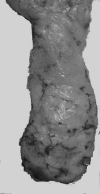The pathologist's role in rectal cancer patient assessments
- PMID: 20011197
- PMCID: PMC2789503
- DOI: 10.1055/s-2007-984860
The pathologist's role in rectal cancer patient assessments
Abstract
Since Cuthbert Dukes fundamental work linking cancer stage to prognosis, the pathologist has had an ever-expanding role in the multidisciplinary management of rectal cancer. Gross dissection techniques and histologic evaluation are reviewed. The evolving tumor size, node status, metastasis classification (TNM) staging system is outlined. The pathologist's critical role in correctly assessing circumferential margins and establishing resection adequacy and staging accuracy via lymph node assessment is emphasized.
Keywords: Rectal cancer; metastasis (TNM) classification; node status; pathological evaluation; total mesorectal excision; tumor size.
Figures




Similar articles
-
Pathologist's perspective on primary rectal cancer.Abdom Radiol (NY). 2019 Nov;44(11):3751-3754. doi: 10.1007/s00261-019-02134-9. Abdom Radiol (NY). 2019. PMID: 31327042 Review.
-
The pathologist's role in the diagnosis and therapy of rectal cancer.Rays. 1995 Jan-Mar;20(1):15-20. Rays. 1995. PMID: 7569064 English, Italian.
-
[Short-term efficacy of robotic-assisted total mesorectal excision with and without lateral lymph node dissection for mid-low advanced rectal cancer: a propensity score matching analysis].Zhonghua Wei Chang Wai Ke Za Zhi. 2020 Apr 25;23(4):370-376. doi: 10.3760/cma.j.cn.441530-20190725-00289. Zhonghua Wei Chang Wai Ke Za Zhi. 2020. PMID: 32306605 Chinese.
-
Postoperative morbidity and mortality after mesorectal excision with and without lateral lymph node dissection for clinical stage II or stage III lower rectal cancer (JCOG0212): results from a multicentre, randomised controlled, non-inferiority trial.Lancet Oncol. 2012 Jun;13(6):616-21. doi: 10.1016/S1470-2045(12)70158-4. Epub 2012 May 15. Lancet Oncol. 2012. PMID: 22591948 Clinical Trial.
-
Sentinel Lymph Node in Breast Cancer: Review Article from a Pathologist's Point of View.J Pathol Transl Med. 2016 Mar;50(2):83-95. doi: 10.4132/jptm.2015.11.23. Epub 2016 Jan 12. J Pathol Transl Med. 2016. PMID: 26757203 Free PMC article. Review.
Cited by
-
Postoperative radio-chemotherapy for rectal cancer: A retrospective analysis from a tertiary referral hospital.Rep Pract Oncol Radiother. 2020 Jul-Aug;25(4):612-618. doi: 10.1016/j.rpor.2020.05.002. Epub 2020 May 23. Rep Pract Oncol Radiother. 2020. PMID: 32536829 Free PMC article.
References
-
- Dukes C. The classification of cancer of the rectum. J Pathol Bacteriol. 1932;35:323–332.
-
- Breasalier R S, Kim Y S. In: Feldman MF, Scharschmidt BF, Sleisenger MH, editor. Gastrointestinal and Liver Disease. Philadelphia: WB Saunders; 1998. Malignant neoplasms of the large intestine. pp. 1923–1926.
-
- Sobin L H, Wittekind C H. TNM Classification of Malignant Tumours. 6th ed. Hoboken, NJ: John Wiley & Sons; 2002.
-
- Gospodarowicz M K, Miller D, Groome P A, Greene F L, Logan P A, Sobin L H. The process for continuous improvement of the TNM classification. Cancer. 2004;100(1):1–5. - PubMed
-
- Goldstein N S, Soman A, Sacksner J. Disparate surgical margin lengths of colorectal resection specimens between in vivo and in vitro measurements. The effects of surgical resection and formalin fixation on organ shrinkage. Am J Clin Pathol. 1999;111(3):349–351. - PubMed

